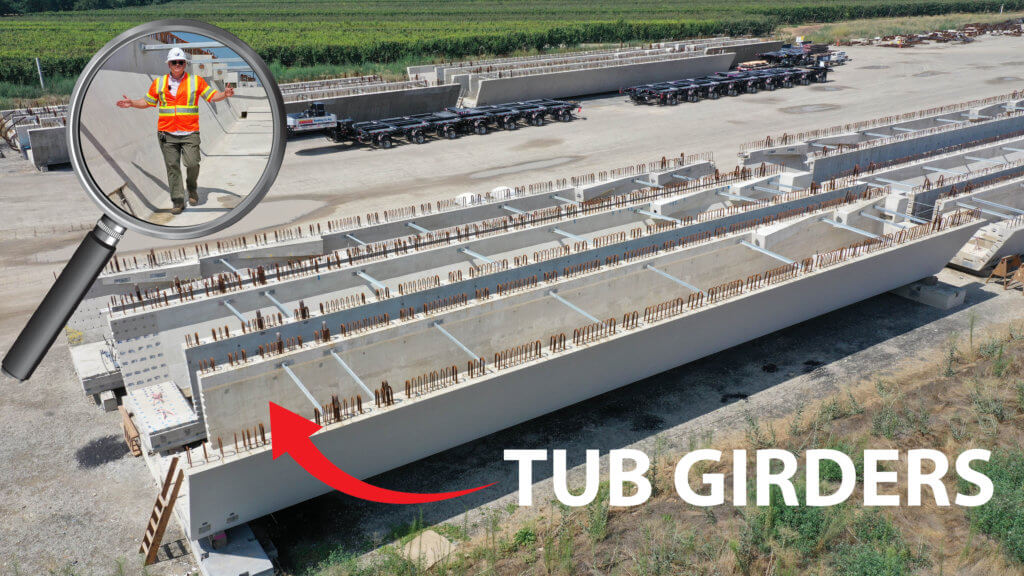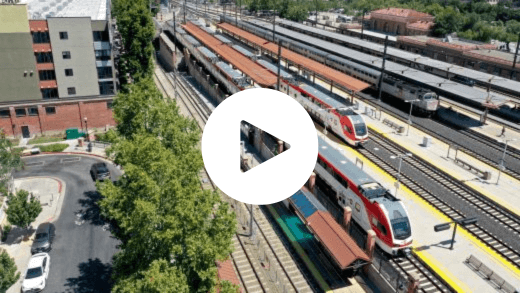|
Statewide News |
Northern California |
Southern California |
FAQs & Upcoming Events |
Program Update – Advancing Construction and Procurements
We’ve left the halfway point for 2023 behind in our rearview mirror and are hitting major milestones on the first high-speed rail project in the nation.
On August 24, our Board of Directors approved the release of a Request for Qualifications (RFQ) for high-speed trainsets to industry. This is the first part of a two-step procurement process.
This trainset procurement process allows us to procure 6 trainsets capable of operating at 220 mph and tested to 242 mph. Two of those prototypes will be delivered in 2028 to support static/dynamic testing and trial running, with the additional four trainsets being delivered by the end of 2030 to support revenue operations of the Merced to Bakersfield section.
These trainsets ensure that we are procuring the latest generation of high-speed trains for this first-in-the-nation project,” said Authority CEO Brian Kelly. “We look forward to working with members of the industry as we strive to develop a market for high-speed trains in the United States.”
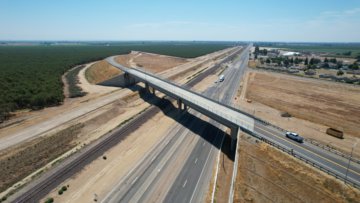 Turning towards construction, earlier this month, we announced the completion of the seventh high-speed rail structure in the Central Valley this year. The Merced Avenue overcrossing and grade separation is located on State Route (SR) 43, south of the city of Wasco in Kern County. Just as a side note, the pre-cast concrete girders needed for the superstructure of this project were the largest girders ever produced in California.
Turning towards construction, earlier this month, we announced the completion of the seventh high-speed rail structure in the Central Valley this year. The Merced Avenue overcrossing and grade separation is located on State Route (SR) 43, south of the city of Wasco in Kern County. Just as a side note, the pre-cast concrete girders needed for the superstructure of this project were the largest girders ever produced in California.
Over the last month, the Authority announced the completion of the Poso Avenue underpass in the city of Wasco and the McCombs Road grade separation located north of the city of Wasco. The Elkhorn Avenue overcrossing in Fresno County was also completed in July. Earlier this year, grade separations at Idaho and Dover avenues in Kings County were also opened to traffic. The Authority also announced the completion of the Cedar Viaduct, a high-speed rail signature structure in Fresno County, in May.
We’re also looking forward to the completion of Construction Package (CP) 4, the southernmost 22 miles of the 119-miles of construction in the Central Valley, this fall. This will be the first construction package completed on this project.
The upcoming completion of CP 4 is the result of our combined efforts to make this project a reality. It required continued engagement with community members and stakeholders, federal grant applications, environmental protections and preventative measures, long hours from our contractor California Rail Builders crews and more to see this through.
It continues to be exciting times here at high-speed rail, and we look forward to sharing our continued progress with you as we roll forward.
ICYMI – Authority Awarded $20 Million in RAISE Grant Funding
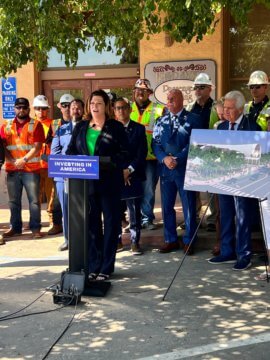 In June, the U.S. Department of Transportation awarded $20 million from the Rebuilding American Infrastructure with Sustainability and Equity (RAISE) program to the Authority for the Fresno High-Speed Rail Station Historic Depot Renovation and Plaza Activation Project.
In June, the U.S. Department of Transportation awarded $20 million from the Rebuilding American Infrastructure with Sustainability and Equity (RAISE) program to the Authority for the Fresno High-Speed Rail Station Historic Depot Renovation and Plaza Activation Project.
The project will restore the historic passenger rail depot building in Fresno, near Chinatown and the site of the future high-speed rail station. The project will also create a functioning park and plazas as spaces for early site activation efforts and integrate critical zero-emissions vehicle infrastructure into historically disadvantaged communities.
In addition to building improvements to the historic depot facility, which include accessibility upgrades and seismic reinforcement, amenities will also include:
- Transit and vehicle electric charging in a resilience hub;
- Solar power generation capacity;
- Bicycle and scooter parking;
- Restored tree canopy and new shade structures;
- Resilient and improved stormwater management;
- Park and plaza space for public activities;
- Lease space opportunities; and
- Improved fencing and perimeter security.
You can read more about this grant award here.
CA HSR’s Gigantic Puzzle Pieces: Pre-Cast Tub Girders
We visited the Dragados-Flatiron Joint Venture Pre-Cast Tub-Girder Facility, located between Selma and Hanford in California’s Central Valley, which manufactures huge structural elements known as tub girders. These gigantic concrete building blocks will help the nation’s first high-speed rail system stay flat and 200 miles-per-hour-fast in the Central Valley. Many of the tub-girders are as long as 110 feet and 14 feet wide. Watch the video to learn more about this innovative construction method being employed to build HSR.
Social Media Round-Up
 In July and August, we celebrated South Asian Heritage Month! We’re proud to take this time to celebrate the vibrant cultures of South Asia and the many contributions South Asians have made to the United States, California and this project. As we do with all our Cultural Awareness Months, we asked employees who wanted to participate to share their stories with us, and if they’re comfortable, to post on social media. Amit Joshi, the Engineering Project Manager for the Merced to Madera section, is proud to celebrate his Indian heritage and shares that his culture and values have helped him succeed as an engineer and as a person. You can see his full thoughts on this occasion here.
In July and August, we celebrated South Asian Heritage Month! We’re proud to take this time to celebrate the vibrant cultures of South Asia and the many contributions South Asians have made to the United States, California and this project. As we do with all our Cultural Awareness Months, we asked employees who wanted to participate to share their stories with us, and if they’re comfortable, to post on social media. Amit Joshi, the Engineering Project Manager for the Merced to Madera section, is proud to celebrate his Indian heritage and shares that his culture and values have helped him succeed as an engineer and as a person. You can see his full thoughts on this occasion here.
Recently, we also hosted a construction tour with high school students from the Mineta Transportation Institute (MTI) summer program at San Jose State University. The tour of high-speed rail construction sites in the Central Valley was part of an intensive three-week program that focused on transportation and environmental curriculum with presentations from California transit leaders and project site visits. You can watch the video on their visit here.
From July 14 to July 15, we attended Family Summer Fun Nights at the California State Railroad Museum! At this event, visitors boarded vintage trains, operated a handcar and learned about California’s rich railroad history. Staff from the Authority, including multiple project engineers, helped children design mock train systems in a kiddie pool filled with gravel and draw a high-speed rail alignment in a hypothetical community, while also providing parents with the latest information on the project. You can watch the video from this event here.
For July’s #WonkWednesday, we reimagined summer trips in California once high-speed rail transforms the way we travel. With fast connections to iconic locations across the Golden State, high-speed rail will provide Californians with the efficient transportation system much of the world already enjoys. You can find the whole thread here.
Make sure to follow us on Twitter, Facebook, Instagram, YouTube and LinkedIn for the latest updates on the project.
| UPDATES FROM NORTHERN CALIFORNIA |
Caltrain’s Game-Changing Electric Trains Hit the Tracks
School was still out for the summer, but 13-year-old Jackson Holquin was up at 5 a.m. on a Saturday for a historic event.
He urged his guardians and siblings to move along. They had to be first in line for the public debut of Caltrain’s new electric fleet. Caltrain’s electric train debut drew 4,000 people to Diridon Station in San Jose on July 29 to walk through the state-of-the-art train cars. The Northern California High-Speed Rail outreach team was on hand to talk about the importance of the electrification effort. The crowd was among the first members of the public to see, feel, and even smell the high-performance trains.
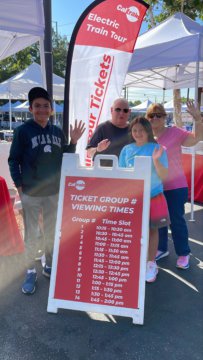 The electric trains are a milestone in Caltrain’s modernization project, which the Authority helped fund and paves the way for future electric high-speed trains along the Caltrain corridor.
The electric trains are a milestone in Caltrain’s modernization project, which the Authority helped fund and paves the way for future electric high-speed trains along the Caltrain corridor.
Holquin said he will, admittedly, kind of miss Caltrain’s diesel trains, but he’s looking forward to the future of electrification: faster rides and better connectivity in the Bay Area. Caltrain and high-speed trains will operate blended service between San Francisco and Gilroy with the Authority’s plans to extend electrified services in the rail corridor from San Jose to Gilroy.
“I’m a train enthusiast. I’m a huge fan. It’s just the love of it – ever since I was born. It’s just in my DNA,” Holquin said while waiting in line and bouncing with excitement.
Once inside the train, there was even more to get excited about.
“It smells like a new car, but like, way more circulated,” Holquin said as he paced through the seven cars of each of the two Stadler KISS bilevel Electric Multiple Units (EMUs) on display at tracks 8 and 9.
The new high-performance trains will offer a better rider experience, according to Caltrain officials. Enhanced amenities include new digital onboard displays, power outlets at each forward-facing seat, a new seat color palette selected by the public, energy-efficient lighting, coat hooks, security cameras, and expanded storage under the cantilevered seats. They will also generate less noise than their diesel equivalent, making the trip more enjoyable both for riders and residents that live near Caltrain tracks.
“They’re so shiny, and I love shiny,” said Aubrie Lee. Lee uses a wheelchair and says it’s more comfortable and much easier to navigate compared to other trains she’s been on. “I like using the bench plate instead of using a lift. The lift takes a lot longer.”
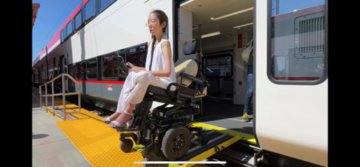 The trains were built by Stadler at their facility in Salt Lake City, Utah. After they were assembled, they were sent to a test facility in Pueblo, Colorado, where they were tested at high speeds under numerous conditions required by the Federal Railroad Administration. The trains have a maximum speed of 110 mph, which will match the maximum speed the Authority is designing the blended service from San Francisco to Gilroy to operate up to in some locations.
The trains were built by Stadler at their facility in Salt Lake City, Utah. After they were assembled, they were sent to a test facility in Pueblo, Colorado, where they were tested at high speeds under numerous conditions required by the Federal Railroad Administration. The trains have a maximum speed of 110 mph, which will match the maximum speed the Authority is designing the blended service from San Francisco to Gilroy to operate up to in some locations.
Electrification will also help meet ambitious regional and state climate action goals by lowering greenhouse gas emissions, improving air quality and relieving traffic congestion. Additionally, electrified service will address historical inequities along transportation corridors by reducing noise and air pollution and increasing access for equity priority communities. Electrification also lays the foundation for California’s future high-speed rail, which will ride on the same rails and use the same overhead electric lines as Caltrain.
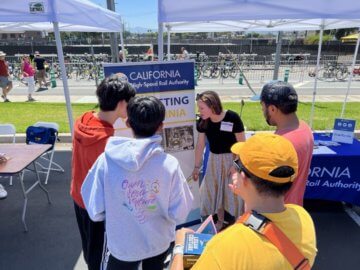
“It is a huge day for Caltrain, and the High-Speed Rail Authority has been right there alongside them the whole time as a supporter and a funding partner in electrification and not only that, but the future infrastructure of high-speed rail in the corridor,” said Morgan Galli, Northern California Deputy Regional Director. “So, it’s really a step in the new future direction of what transportation will be right here in the Bay Area.”
The California High-Speed Rail Authority contributed $714 million to the electrification project. It will also extend electrification to Gilroy and Merced, and thus service to the southern most parts of the region.
“Next stop is Gilroy, and we’re really excited about that, but funding is the key,” said Gilroy Mayor Marie Blankley. “Unfortunately, Gilroy won’t see electric trains until high-speed rail comes forward and electrifies the tracks.”
The debut of the Caltrain’s electric trains is a milestone in the larger vision for transportation throughout the state, she said. “It shows the importance of transportation and that we’re making progress,” Blankley said.
Caltrain’s new EMUs will go into service in 2024. More public tours of the new vehicles are planned for later this year.
Learn more about how the modernization project sets up the framework for High-Speed Rail in the Bay Area in this video.
Northern California Director Boris Lipkin Named to 40 Under 40 List
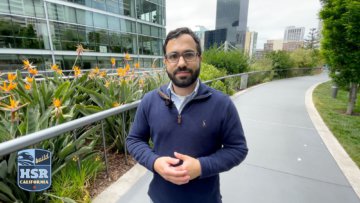 The Authority is proud to celebrate Northern California Regional Director Boris Lipkin being name to Mass Transit Magazine’s 40 Under 40 list, which recognizes outstanding young individuals who are making a big difference in America’s public transit industry. Lipkin’s career demonstrates his commitment to high-speed rail in the United States and contributions have moved the country closer than ever before to this reality. Lipkin began work on California’s transformative high-speed rail project at age 23. At 27, he was appointed by Governor Jerry Brown as the Deputy Director of Strategic Planning; and at 30, he was appointed as Northern California Regional Director for the country’s largest infrastructure project. The 40 Under 40 honors over a decade of his dedication and tremendous contributions to making high-speed rail a reality in California.
The Authority is proud to celebrate Northern California Regional Director Boris Lipkin being name to Mass Transit Magazine’s 40 Under 40 list, which recognizes outstanding young individuals who are making a big difference in America’s public transit industry. Lipkin’s career demonstrates his commitment to high-speed rail in the United States and contributions have moved the country closer than ever before to this reality. Lipkin began work on California’s transformative high-speed rail project at age 23. At 27, he was appointed by Governor Jerry Brown as the Deputy Director of Strategic Planning; and at 30, he was appointed as Northern California Regional Director for the country’s largest infrastructure project. The 40 Under 40 honors over a decade of his dedication and tremendous contributions to making high-speed rail a reality in California.
Lipkin started working for the California High-Speed Rail Authority (Authority) as a consultant developing ridership forecasts, economic analysis, funding plans and strategies to access and secure funding for the project. His innovative thinking quickly caught the eye of the then-CEO. At age 27, he was appointed by Governor Jerry Brown as the Authority’s first Deputy Director of Strategic Planning. He worked to solve some of the biggest challenges, including developing and executing a multistep plan to access $3 billion in state bond funds. Just three years later, at age 30, Lipkin was appointed by Brown to lead the development of high-speed rail in Northern California as the Northern California Regional Director and in 2020 he was reappointed by Governor Gavin Newsom to that position.
During his tenure as the Northern California Regional Director, Lipkin led the successful certification of environmental clearance for almost 150 miles of high-speed rail in Northern California from San Francisco to Merced. At the time of his initial appointment in 2018, the Authority had been working on environmental clearance for nearly eight years. When the environmental documents were complete in 2022 and the Authority Board were presented with their votes to certify the documents, they were meet with overwhelming support from regional stakeholders and unanimously approved both documents.
He’s hosted and has been featured in several not-to-be-missed social media events where he’s made the world of high-speed rail accessible to the public. Lipkin hosted a Reddit Ask Me Anything; a town hall live from Salesforce Transit Center; and an interview series featuring transportation leaders in the Bay Area and transportation professionals working on high-speed-rail, such as former Metropolitan Transportation Commission’s Executive Director Therese McMillian.
The Authority thanks Boris for his dedication to the high-speed rail program and celebrates this national recognition for his contributions to transforming the public transit industry by influencing a significant shift in policy and public opinion in support of clean, electrified high-speed rail in the United States.
HSR Celebrates Pride
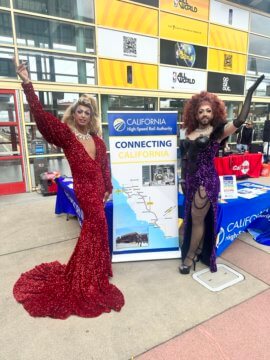 In the spirit of unity, love, and resilience, the California High-Speed Rail Authority and Caltrain joined forces to celebrate the 53rd annual Pride celebration in San Francisco on June 25. Revelers aboard special Caltrain Pride trains arrived at San Francisco’s 4th and King station to a welcome party filled with booming music, rainbows galore, and information on how the Authority is working toward a brighter and more inclusive future for all Californians.
In the spirit of unity, love, and resilience, the California High-Speed Rail Authority and Caltrain joined forces to celebrate the 53rd annual Pride celebration in San Francisco on June 25. Revelers aboard special Caltrain Pride trains arrived at San Francisco’s 4th and King station to a welcome party filled with booming music, rainbows galore, and information on how the Authority is working toward a brighter and more inclusive future for all Californians.
“In California, diversity is our strength, and the same is true at the Authority,” said Brian Kelly, Chief Executive Officer of the Authority. “No matter who you love, or how you identify, you have a place in California and here at the Authority.
The electric, inclusive energy from the crowd mirrored the vision shared by the Authority and Caltrain in Northern California. By 2024, Caltrain will begin passenger service on new state-of-the-art electric trains. The electrified corridor between San Francisco and San Jose will provide faster, quieter, greener, and more frequent service. Not only that, Caltrain Electrification paves the way for future high-speed rail service.
“As a queer-identifying staff member, I am very proud to be working to bring all of California together,” said Jean-Paul Torres, Northern California Outreach Specialist. “This is a project of a lifetime and it’s such a joy to celebrate our diverse communities in a way that makes them feel seen, validated and embraced for being their truest selves.“
Check out the highlights of our outreach efforts on Instagram that show all the fun from the annual Pride event!
Taking it to the Market
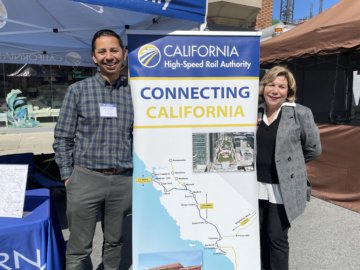 It’s said food brings people together. In the spirit of building connections, the California High-Speed Rail Authority frequently sets up informational booths alongside farmers and food purveyors at farmers’ markets. As summer weather settled into the Bay Area, the outreach team met Californians at multiple farmers’ markets, including the Burlingame Fresh Market. Visitors asked questions, shared their opinions, and even learned about the project for the very first time.
It’s said food brings people together. In the spirit of building connections, the California High-Speed Rail Authority frequently sets up informational booths alongside farmers and food purveyors at farmers’ markets. As summer weather settled into the Bay Area, the outreach team met Californians at multiple farmers’ markets, including the Burlingame Fresh Market. Visitors asked questions, shared their opinions, and even learned about the project for the very first time.
Organizers for the market say they look forward to seeing High Speed Rail at larger events to reach more people as they enjoy Burlingame’s offerings.
“I am so excited California High-Speed Rail joined our Thursday Fresh Market event. I love that we can help get the message out to our community,” said Susan Baker, President and CEO of the Burlingame/SFO Chamber of Commerce. “Connecting southern and northern California with an efficient high-speed rail not only benefits the entire State but also makes economic sense. Our Burlingame community also benefits.”
Environmental Consultant Gets Creative to Save Wetland Species
Before the bulldozers and concrete trucks break ground, there’s Brent Helm. He’s a biologist and ecologist who specializes in preserving wetlands. When the California High-Speed Rail Authority begins work on a project, it’s Helm who is often the first boots on the ground.
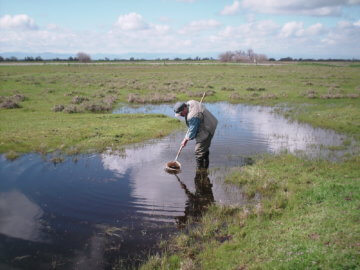 While the project has big intentions, Helm is worried about the little things – fairy shrimp, specifically. Helm has been all over the state while working for the Authority. An expert in wetlands, he geeks out talking about fairy shrimp. The one-inch-long crustaceans live in vernal pools as far south as Visalia, where Helm helped build refuges to support the invertebrates.
While the project has big intentions, Helm is worried about the little things – fairy shrimp, specifically. Helm has been all over the state while working for the Authority. An expert in wetlands, he geeks out talking about fairy shrimp. The one-inch-long crustaceans live in vernal pools as far south as Visalia, where Helm helped build refuges to support the invertebrates.
While wildlife and wild spaces are sparse in the Central Valley, Helm says the Bay Area presents a stark contrast, with its dense concentration of sensitive habitats and dependent species.
“The Bay Area is going to be very rich. There’s a lot of teeny species and a lot of cool habitats as well,” he said.
Big or little, it’s Helm’s job to make sure California wildlife is front and center in the Authority’s building process. His company, Helm Biological Consulting, is a certified small business. It’s an environmental consulting firm specializing in biological resource studies, mitigation banking, habitat establishment and ecological research. He has another small business, Wetland Construction Team, which builds wetlands.
The businesses are small, which means Helm is wearing waders or rubber boots almost 365 days a year.
As part of the construction process, the Authority has preserved thousands of acres of land to mitigate the effects of building a high-speed rail line. Helm figures out how to conserve land in a way that supports as much biodiversity as possible. He surveys the ecology, determines what would best suit the creatures in that area, then he builds a proper wetland to support that life.
Often, that means getting creative.
“We do weird stuff,” Helm said, chuckling as he thinks about both the tiny wildlife and large animals he works with. “A guy I work with says ‘Brent can build wetlands on the moon if you give him enough money and time.’”
He’s had plenty of work to do. In Tulare County, Helm helped build the Cottonwood Creek mitigation site, which is one of the few areas set aside for wildlife in the farm-rich Central Valley. Going green is a core mission for the Authority. Yes, we’re delivering green transportation, powered by 100% renewable energy. The Authority is also going the extra mile to protect the environment. To date, we have preserved and restored about 3,000 acres of habitat, giving species both rare and not-so-rare a place to call home in the crowded Central Valley farmlands. The Authority relies on Helm and other consultants’ abilities to think outside the box to realize this enormous project.
“From what I’ve seen, the mitigation that the high-speed rail has done is probably more than adequate compared to other projects,” Helm said. “They took it on the chin and a lot of the mitigation is larger than what it would have been if somebody else was doing the work. I think there’s some really unique habitats being preserved.”
The commitment to wildlife even includes inventing a unique electrification system, which will prevent our state’s giant California condors from getting electrocuted by the overhead wires.
The diversity of the Bay Area’s ecosystem is exciting to Helm. His office is in Sheridan in Placer County, but he can regularly be found in waders or muck boots throughout the state. He likes to say he sees wetlands every day of the year, though there’s an occasional visit to Florida to see his grandchildren. As the high-speed rail project heads toward the Bay Area, Helm will likely be there, helping the project steer through a phalanx of environmental laws to do right by California’s wildlife.
| UPDATES FROM SOUTHERN CALIFORNIA |
What’s Happening in Southern California: Building the Future
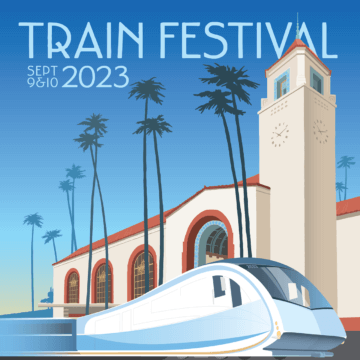 Los Angeles Union Station will be the center of the West Coast railroading world on September 9 and 10 as it hosts its annual Train Festival. This year’s edition focuses on the past, present and future of rail travel, and the High-Speed Rail Authority will be on hand to talk about where we’re going and how we’re going to get there.
Los Angeles Union Station will be the center of the West Coast railroading world on September 9 and 10 as it hosts its annual Train Festival. This year’s edition focuses on the past, present and future of rail travel, and the High-Speed Rail Authority will be on hand to talk about where we’re going and how we’re going to get there.
The event is free and open to everybody. There will be things to see and do throughout Union Station, including live music and food trucks.
But we all know the trains will be the center of attention. There will be items old and new on hand, with a vintage private car, historic freight and modern passenger rail for visitors to peruse. There will be historic tours, including a look at the sublime artwork around Union Station, which opened in 1939.
Model train fans will get into the fun with a display of rare trains. And there will even be giveaways over the course of the two-day event. The High-Speed Rail Authority will bring items for both kids and adults, with coloring books and crayons for the youngsters and facts and information for the adults.
For more information, visit Eventbrite.
Delivering Solar-Powered High-Speed Rail
Not only is high-speed rail moving people around the state, but we’re also doing it with 100% renewable solar energy.
The Authority joined the American Public Transportation Association’s annual conference in Anaheim in early August to talk about sustainability. Meg Cederoth, our Director of Planning and Sustainability, took part in a great conversation about the zero-emission future of transportation. She was joined by representatives from the Southern California Regional Rail Authority, East Japan Railway Company and Orange County Transportation Authority.
And in the main reception area, our Southern California outreach team met with transportation leaders from around the country. Everybody was curious for construction updates and expressed support for our work. It’s important and people at the heart of the transportation industry are rooting for us.
A Conversation with WTS Los Angeles
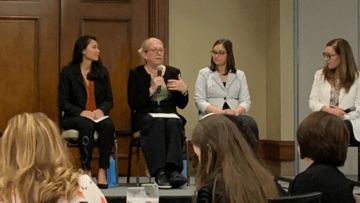 We love talking about trains, but it was extra special on Aug. 23 to hang out with our friends from Metrolink, LA Metro and Union Pacific Railroad. Our Southern California Regional Director, Donna DiCamillo, talked about women in rail at a WTS Los Angeles event with Elizabeth Lun of Metrolink, Avital Barnea of LA Metro and Lupe Valdez of Union Pacific. We’ve previously been honored as the Employer of the Year from multiple WTS Chapters, including WTS Los Angeles, for our work supporting and advancing the careers of women in the transportation industry.
We love talking about trains, but it was extra special on Aug. 23 to hang out with our friends from Metrolink, LA Metro and Union Pacific Railroad. Our Southern California Regional Director, Donna DiCamillo, talked about women in rail at a WTS Los Angeles event with Elizabeth Lun of Metrolink, Avital Barnea of LA Metro and Lupe Valdez of Union Pacific. We’ve previously been honored as the Employer of the Year from multiple WTS Chapters, including WTS Los Angeles, for our work supporting and advancing the careers of women in the transportation industry.
Rosecrans/Marquardt Grade Separation Project on Track for 2025 Completion
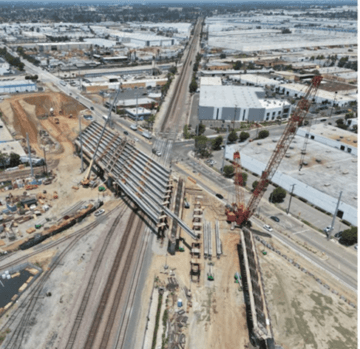 Once regarded as the most hazardous at-grade railroad crossing in California, LA Metro’s Rosecrans Ave and Marquardt Ave grade separation project continues to inch closer to completion. The grade separation will elevate the road above the railroad, allowing vehicles and trains alike to continue their journeys without disrupting one another.
Once regarded as the most hazardous at-grade railroad crossing in California, LA Metro’s Rosecrans Ave and Marquardt Ave grade separation project continues to inch closer to completion. The grade separation will elevate the road above the railroad, allowing vehicles and trains alike to continue their journeys without disrupting one another.
Funded partially by a $77 million investment from the California High-Speed Rail Authority, the project will convert Rosecrans Ave into a bridge, while Marquardt Ave is realigned below and away from railroad tracks. The grade separation will substantially improve safety and traffic flow, increase the efficiency of train movements, and reduce greenhouse gas emissions. In the future, it will accommodate high-speed rail.
This summer, construction crews completed a major project milestone with the installation of all girders for the new Rosecrans Ave Bridge. The bridge, expected to open by March 2024, will shift traffic away from the roadways and allow construction crews to begin significant work on the realignment of Marquardt Ave and the installation of new traffic signals on both ends of the bridge.
Metro expects the realigned roadway work to complete by January 2025, with full project completion in March 2025.
Earth Mechanics, Inc.
Depending on who you ask, the 1980s are responsible for everything good in this world. From the action-packed blockbuster movies that Hollywood continues to remake, the introduction of the World Wide Web and for Lino Cheang and Po Lam – the founding of Earth Mechanics Inc. (EMI). Founded in 1989, EMI punched its ticket into the 80s with a buzzer-beater. Fitting, considering that Michael Jordan’s iconic buzzer-beater, “The Shot”, occurred during the 1989 Eastern Conference playoffs. Surely just a coincidence.
Cheang and Lam were both degreed with a background in designing foundations for coastal and offshore structures. Originally focused on the oil and gas industry, EMI shifted attention to California bridges after the industry downturn in the mid-80s. EMI faced the challenge of developing its business in its early days, relying mainly on previous professional contacts and clients for contracts.
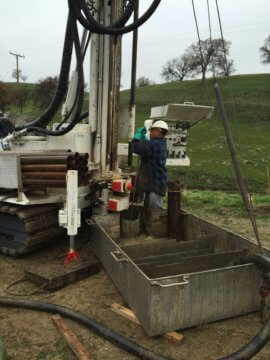 Their breakthrough came when Lam joined a committee established by Caltrans following the Loma Prieta and Northridge Earthquakes. Caltrans initiated a bridge seismic retrofit program to address earthquake vulnerabilities in older structures. Lam’s contributions, which included a seismic evaluation policy for bridges, played a significant role in EMI’s growth. As a result, EMI quickly gained industry recognition, expanded its client base and opened additional offices in San Diego, Orange and Alameda counties over time.
Their breakthrough came when Lam joined a committee established by Caltrans following the Loma Prieta and Northridge Earthquakes. Caltrans initiated a bridge seismic retrofit program to address earthquake vulnerabilities in older structures. Lam’s contributions, which included a seismic evaluation policy for bridges, played a significant role in EMI’s growth. As a result, EMI quickly gained industry recognition, expanded its client base and opened additional offices in San Diego, Orange and Alameda counties over time.
EMI has been involved in the California High-Speed Rail project for over a decade. They are currently on board as a geotechnical consultant for the 31 bridges and viaducts along the Bakersfield to Palmdale segment, responsible for supporting the structure designers with identifying the geologic and geotechnical hazards for each of the 31 structures. Additionally, EMI is tasked with preparing the preliminary foundation design recommendations for each structure and with the development of a geotechnical investigation plan that will assist the Authority to secure permits required to perform geotechnical site investigation at the 65% design phase.
Eric Brown, Principal at EMI, is encouraged by the investment placed in bringing a high-speed rail system to the west coast. “It is a monumental task linking Southern and Northern California via high-speed rail, but it will be the backbone of a much larger system that will continue to expand long after my career is over. The fact that there is already another high-speed rail system in design is a testament to that.” In addition to the California High-Speed Rail project, EMI is also working on Brightline West’s High-Speed Rail project connecting Southern California to Las Vegas. Brown adds, “That project doesn’t happen if the CA HSR project doesn’t happen first.”
Like the structures they work on, EMI’s success has been stable and resilient. The company was fortunate to have not lost a single employee throughout the COVID-19 pandemic and today employs 35 staff. They’re confident that what Cheang and Lam built decades ago is sustainable for years to come. Brown shares, “Our goal for the future is to continue to keep our clients happy so that we can continue to have the opportunity to work on interesting projects such as the CA HSR project and the other projects that we are fortunate to work on.”
Frequently Asked Questions
California high-speed rail staff respond to many inquiries from residents, local agencies, neighborhood groups, and other stakeholders. Here we answer some of the more common questions about the program.
Will Caltrain and high-speed trains operate at the same speed in the Bay Area?
Caltrain will introduce electric train service in 2024. This will allow Caltrain to increase service throughout the corridor. Right now, and with electrification, the Caltrain corridor allows trains to operate at a maximum of 79 mph. Caltrain’s new electric trains have the capability of operating at a maximum of 110 mph; however, the curvature of the existing tracks can only accommodate speeds of up to 79 mph. The Authority has designed the corridor from San Francisco to Gilroy to allow train speeds to hit 110 mph. How do we do that? The Authority will flatten or straighten curves to accommodate faster trains. With coordinated schedule planning, as well as additional opportunities for high-speed trains to pass Caltrain trains at stations, high-speed trains will be able to zoom through the Bay Area at 110 mph.
High-speed rail will run on the same tracks and share the same electric system. But that doesn’t mean train service from two organizations will cause bottlenecks.
What kind of tunnels are being dug for high-speed rail in Southern California?
Much of the high-speed rail project in Southern California will be underground. We’re planning to build 13 tunnels and more than 40 miles of tunnels between Bakersfield and Burbank. Some of the tunnels are short, covering less than a mile. Others will be some of the longest tunnels in the world, with a pair of digs slated to cover 13 miles each.
The result of all that digging is speed. It currently takes about an hour to drive from Palmdale to Burbank. It’s about an hour and a half on existing public transit. Our trains will make the 38-mile trip in about 15 minutes, start to finish. That kind of connection will make Palmdale easily commutable to the Los Angeles area.
Upcoming Events
Here are upcoming events that you won’t want to miss!
Mission Community Market
August 31, 2023
3 p.m. – 7 p.m.
Authority staff will be at the Mission Community Market. Stop by to stock up on fresh produce and talk with us about high-speed rail. Click here for more information.
TrainFest
September 9-10, 2023
10 a.m. – 6 p.m.
Authority staff will participate in TrainFest at the Los Angeles Union Station to celebrate the past, present and future of train travel with activations and programs throughout the iconic Los Angeles landmark. Click here for more information.
Viva CalleSJ
September 10, 2023
10 a.m. – 3 p.m.
Authority staff will have an informational booth at Viva CalleSJ at Tamien Park in San Jose. Click here for more information.
56th Annual Native American Day
September 22, 2023
10 a.m. – 2 p.m.
Authority staff will have an informational booth at the 56th Annual Native American Day at the State Capitol building in downtown Sacramento. Click here for more information.
Caltrain Electric Train Tour – San Francisco
September 23, 2023
10 a.m. – 2 p.m.
Authority representatives will be joining Caltrain as it continues it electric train tour. Stop by to learn more about this partnership RSVPs are encouraged.
559 Night Market
September 29, 2023
4 p.m. – 8:30 p.m.
Authority staff will have an informational booth at Fresno’s 559 Night Market near the Chinatown neighborhood in Fresno. Click here for more information.
Please be sure to check our events page and follow us on social media to learn about upcoming events.
Quarterly Newsletter Archive
- Spring 2023 All Aboard Newsletter
- Winter 2023 Quarterly Newsletter
- Fall 2022 Quarterly Newsletter
- Summer 2022 Quarterly Newsletter
- Spring 2022 Quarterly Newsletter
- Winter 2022 Quarterly Newsletter
- Fall 2021 Quarterly Newsletter
- Summer 2021 Quarterly Newsletter
- Regional Newsletter - May 2021
- Regional Newsletter - February 2021
- Regional Newsletter - November 2020
- Regional Newsletter - August 2020
- Regional Newsletter - June 2020
- Regional Newsletter - February 2020
- Regional Newsletter - November 2019
- Regional Newsletter - August 2019
The California High-Speed Rail Authority makes every effort to ensure the website and its contents meet mandated ADA requirements as per the California State mandated Web Content Accessibility Guidelines 2.0 Level AA standard. If you are looking for a particular document not located on the California High-Speed Rail Authority website, you may make a request for the document under the Public Records Act through the Public Records Act page. If you have any questions about the website or its contents, please contact the Authority at info@hsr.ca.gov.



